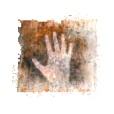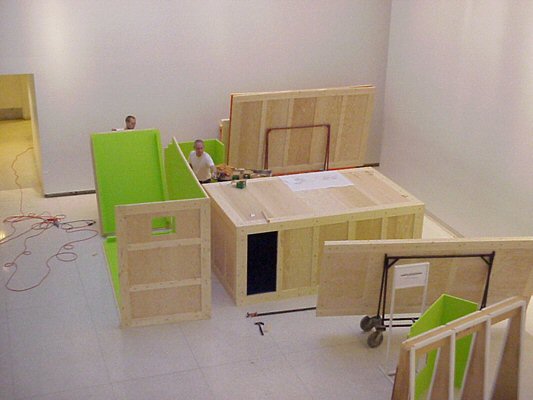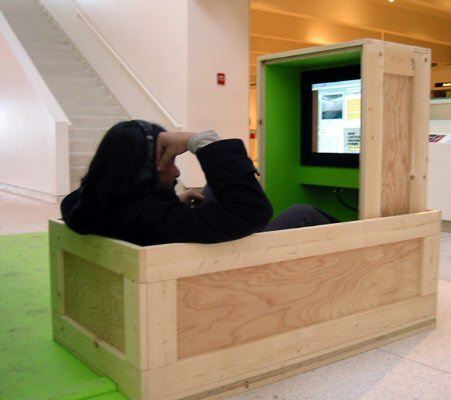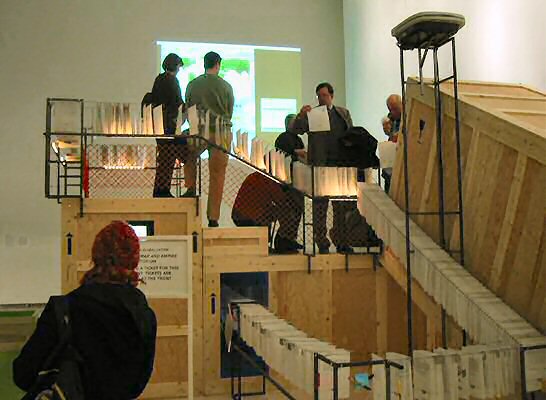Please wait a few moments while we process your request

RAQS Media Collective & Atelier Bow Wow
Temporary Autonomous Sarai
(Minneapolis, Minnesota, United States)
Commissioned by the Walker Art Center and funded by the Foundation, Temporary Autonomous Sarai is an installation and interdisciplinary collaboration between RAQS Media Collective (New Delhi) and the architectural firm Atelier Bow Wow (Tokyo). Created for Translocations, an online exhibition highlighting network-based art, Temporary Autonomous Sarai is a physical space that encourages visitors to discover net art by 14 artists from Brazil, China, India, Japan, South Africa, Turkey and the United States. Graduate students in architecture and design at the University of Minnesota also took part in the conceptual research that spawned Temporary Autonomous Sarai.
Curated by Steve Dietz, the online Translocations exhibition was incorporated within the touring Walker Art Centre exhibition How Latitudes Become Forms: Art in a Global Age. A sly reference to When Attitudes Become Form, the influential exhibition mounted in 1969 by Harald Szeemann in Berne, Switzerland, How Latitudes Become Forms examines the ways which globalisation is affecting contemporary visual culture.
The projects presented in Translocations explore the “translocal” concept (1), which refers to how local initiatives network and operate across a larger geographical and cultural system. The exhibition seeks to examine how artists who rely on the Internet in their work, explore from an artistic and critical perspective the notion and the role of the local in an increasingly globalised and networked society. (2)
The term “sarai” (from caravansarai) has its roots in Mughal India and conveys the origin and aim of the Temporary Autonomous Sarai project. At once a destination and point of departure, sarai refers to an enclosed space in a town or beside a road where travellers from all walks of life and social classes could find refuge, food and company. Sarai was also a stage used for theatre, music, dervish dancing and philosophical discussions. Hence, the concept of sarai, which evokes conviviality and cultural exchange applies to an exhibition that explores the notion of "translocal." Inspired by and emulating certain aspects of this rich tradition, Raqs and Bow Wow have designed a physically modest and temporary structure that, in the spirit of sarai, encourages people to meet and share.
RAQS Media Collective was founded in New Delhi, India, in 1991 by Jeebesh Bagchi, Monica Narula and Shuddhabrata Sengupta in order to pursue their interest in documentary cinema. Over the years, their work has become increasingly diverse, integrating historical research, criticism, curating, and archive and database development. Raqs has also created public spaces in an effort to showcase new cultural practices, digital and media arts, photography, graphic design, the Internet and cyberculture. In 2001, RAQS teamed up with Ravi Vasudevan and Ravi Sundaram to co-founded the Sarai New Media Initiative, an organisation that the Foundation has funded. (3)
Set up in Tokyo in 1992, Atelier Bow Wow is an architectural firm run by Yoshiharu Tsukamoto and Momoyo Kaijima. Leaders of a new generation of Japanese architects and proponents of an architectural trend they call da-me (or "no-good architecture"), they favour an adaptive aesthetic of structures with varied and utilitarian uses.
Curated by Steve Dietz, the online Translocations exhibition was incorporated within the touring Walker Art Centre exhibition How Latitudes Become Forms: Art in a Global Age. A sly reference to When Attitudes Become Form, the influential exhibition mounted in 1969 by Harald Szeemann in Berne, Switzerland, How Latitudes Become Forms examines the ways which globalisation is affecting contemporary visual culture.
The projects presented in Translocations explore the “translocal” concept (1), which refers to how local initiatives network and operate across a larger geographical and cultural system. The exhibition seeks to examine how artists who rely on the Internet in their work, explore from an artistic and critical perspective the notion and the role of the local in an increasingly globalised and networked society. (2)
The term “sarai” (from caravansarai) has its roots in Mughal India and conveys the origin and aim of the Temporary Autonomous Sarai project. At once a destination and point of departure, sarai refers to an enclosed space in a town or beside a road where travellers from all walks of life and social classes could find refuge, food and company. Sarai was also a stage used for theatre, music, dervish dancing and philosophical discussions. Hence, the concept of sarai, which evokes conviviality and cultural exchange applies to an exhibition that explores the notion of "translocal." Inspired by and emulating certain aspects of this rich tradition, Raqs and Bow Wow have designed a physically modest and temporary structure that, in the spirit of sarai, encourages people to meet and share.
RAQS Media Collective was founded in New Delhi, India, in 1991 by Jeebesh Bagchi, Monica Narula and Shuddhabrata Sengupta in order to pursue their interest in documentary cinema. Over the years, their work has become increasingly diverse, integrating historical research, criticism, curating, and archive and database development. Raqs has also created public spaces in an effort to showcase new cultural practices, digital and media arts, photography, graphic design, the Internet and cyberculture. In 2001, RAQS teamed up with Ravi Vasudevan and Ravi Sundaram to co-founded the Sarai New Media Initiative, an organisation that the Foundation has funded. (3)
Set up in Tokyo in 1992, Atelier Bow Wow is an architectural firm run by Yoshiharu Tsukamoto and Momoyo Kaijima. Leaders of a new generation of Japanese architects and proponents of an architectural trend they call da-me (or "no-good architecture"), they favour an adaptive aesthetic of structures with varied and utilitarian uses.
Raphaëlle Aubin © 2007 FDL
(1) For more information on the concept of "translocal," see Andreas Broeckmann's text "translocation_new media/art": http://www.translocation.at/d/broeckmann.htm
(2) This excerpt comes from the proposal submitted to the Foundation.
(3) This project received the Foundation's support in 2001. http://www.sarai.net
Index:
- DLF Projects in India
• Legend of the Sea Lord
• Ring of Blue
• Recurrencies
• TyPoCiTy
• Nagarika
• Temporary Autonomous Sarai
• Sarai Interface Zone
• Sarai Media Lab
External links:
Translocations: Online Work:
http://latitudes.walkerart.org/translocati...
http://latitudes.walkerart.org/translocati...
Raqs Media Collective:
http://www.raqsmediacollective.net
http://www.raqsmediacollective.net
Atelier Bow-Wow:
http://www.bow-wow.jp
http://www.bow-wow.jp









